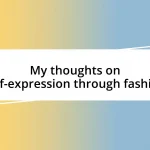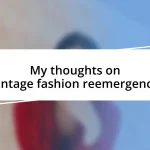Key takeaways:
- Bespoke fashion emphasizes a personalized journey, starting from client consultations to fabric selection and fitting sessions that capture individual essence and enhance confidence.
- Material selection is crucial, considering durability, comfort, color, seasonality, and sustainability to ensure designs resonate with users’ emotions and environmental responsibility.
- Building a loyal customer base relies on nurturing relationships through personalized experiences, open communication, follow-ups, and shared stories that engage clients emotionally and encourage repeat business.

Understanding bespoke fashion process
Understanding the bespoke fashion process begins with an intimate consultation between the designer and the client. I remember the first time I sat down with a client eager to design their dream outfit. It was fascinating to hear their vision, fears, and aspirations for how they wanted to be represented through clothing. Have you ever felt that your clothing didn’t truly reflect who you are? That’s the heart of bespoke fashion—it’s all about capturing your unique essence.
Next comes the fabric selection, which is an entire adventure in itself. I often find myself getting lost in the textures and colors, reminiscing about how a particular fabric once made me feel during a significant event. It’s surprising how choosing the right material can evoke emotions; that silk I once picked for a summer dress reminded me of a sunlit afternoon spent laughing with friends. When you’re part of this process, it’s more than just picking fabrics; it’s about feeling connected to your choices.
Finally, the fitting sessions are where the magic truly happens. Each fitting is a dialogue of its own, where adjustments transform a garment from a mere idea into a wearable piece of art tailored to perfection. It’s during these moments when I realize how powerful bespoke fashion can be—can you imagine the confidence boost a perfect fit can give? Witnessing my clients’ smiles as we inch closer to their vision makes every minute of the process worthwhile.

Choosing materials for bespoke designs
Choosing the right materials for bespoke designs is an exciting journey filled with possibilities. I still remember a particular project where I had the chance to work with a fabric sourced from a local artisan. The moment I ran my fingers over the handwoven texture, I felt an immediate connection. It was as if the fabric whispered stories of its origin. I think that’s what makes the material selection phase so crucial; it sets the tone for the entire piece and informs every stitch that follows.
When selecting materials, keep these key points in mind:
- Durability: Consider how the fabric will wear over time. Some materials, while beautiful, may not hold up to frequent use.
- Comfort: It’s vital that the wearer feels at ease. Fabrics like soft cotton or luxurious modal can feel great against the skin.
- Color and Pattern: Think about how these elements convey the intended message or mood of the design. A vibrant print can energize, while a muted palette may evoke elegance.
- Seasonality: Choose fabrics that suit the intended season. Lightweight linens are perfect for summer, while thicker wools work wonders in winter.
- Sustainability: Whenever possible, opt for eco-friendly materials. This not only benefits the environment but also adds a layer of meaning to the design.

Techniques for personalized fittings
When it comes to personalized fittings, one technique I often use is taking a series of precise measurements. Early in my journey, I had a client who was self-conscious about their body shape. During our first fitting, I made it a priority to ensure they felt reassured by explaining every measurement I took. It’s not just about numbers; it’s about building trust. A thorough measurement process helps create a foundation that ensures the final garment feels like a second skin.
Another valuable approach I employ is the use of muslins, or mock-ups, which allow clients to see and feel their design before the final fabric is cut. I once worked with a bride who was concerned about the fit of her gown. The muslin fitting made all the difference; it gave her the freedom to visualize and refine the silhouette. That moment when she saw the gown take shape was magical—her excitement reaffirmed how crucial this step truly is.
Lastly, I believe in an iterative approach during fittings, where we gather feedback and make small adjustments. I had a male client who wanted a tailored suit but was unsure of what style suited him best. After two fitting sessions, we had shifted details like lapel width and trouser fit based on his evolving preferences. Watching him step out in a suit that truly represented who he was made it all worthwhile. Personalization is not just about the product—it’s about the entire experience.
| Technique | Description |
|---|---|
| Precise Measurements | Building trust through accurate measurements ensures a perfect fit and enhances the client’s comfort. |
| Muslins | Using mock-ups allows clients to visualize and refine designs, contributing to their excitement and confidence. |
| Iterative Feedback | Adjusting the design based on client input creates a garment that truly reflects their personal style and needs. |

Collaborating with artisans and tailors
Working with artisans and tailors is truly where the magic of bespoke fashion happens. I remember a project where we collaborated with a talented artisan who specialized in intricate embroidery. As I watched them meticulously stitch each design element, I was struck by the care and passion they poured into their craft. It wasn’t just about creating a garment; it felt like we were weaving stories and emotions into every thread.
One day, I had the chance to team up with a tailor who had decades of experience under his belt. I was nervous, wondering if my fresh ideas would clash with his established techniques. To my surprise, he encouraged my creative input and taught me how traditional methods could be adapted to fit contemporary designs. This experience taught me that collaboration is about blending visions and learning from each other. Aren’t those moments when you realize that art transcends generations what truly make this craft rewarding?
A key takeaway from my collaborations is communication. I recall working on a bespoke bridal gown, where the bride had specific elements in mind but struggled to articulate them. I found that asking guiding questions helped her uncover her vision, leading to a beautiful design that reflected her personality. This back-and-forth with both artisans and clients not only paves the way for stunning creations but also deepens relationships within the bespoke fashion community. Have you ever experienced that transformation in collaboration? It’s truly exhilarating!

Key challenges in bespoke fashion
One of the key challenges in bespoke fashion is managing client expectations. I once had a client who envisioned a lavish ball gown yet had a tight budget. During our discussions, I realized it was crucial to help her understand where we could save without compromising the essence of her dream dress. Through open dialogue, we found a beautiful fabric that met her budget, proving that flexibility and clear communication are essential in this industry.
Time constraints also pose a significant hurdle in bespoke design. I remember working with a client who needed a custom suit for an upcoming event but only gave me a week’s notice. The pressure was palpable; I had to streamline my usual process while still ensuring the fit and quality were top-notch. I learned that under pressure, prioritizing essential elements—like fit over intricate details—can still yield a stunning result. Have you ever faced a situation where you had to think quickly to meet a deadline?
Another challenge is sourcing the right materials. There have been times when a fabric I envisioned using for a design was suddenly discontinued. I recall being heartbroken when a dreamy silk blend disappeared from supply catalogs. Instead of giving up, I turned to alternative materials that unexpectedly elevated the design. This adaptability in finding substitutes helped me appreciate the creative journey and reminded me that sometimes setbacks lead to surprisingly beautiful outcomes.

Marketing your bespoke creations
Marketing bespoke fashion creations is as much about storytelling as it is about the garments themselves. I vividly recall launching a collection where I shared my design journey on social media, weaving in personal anecdotes about each piece’s inspiration. This approach allowed potential clients to connect emotionally, transforming them from casual observers into enthusiastic supporters of my artistry. Have you ever thought about how sharing your creative process could resonate with your audience?
Another effective strategy I discovered was hosting intimate events where clients could experience the craftsmanship firsthand. I organized a small gathering showcasing a few bespoke pieces, allowing guests to touch the fabrics and appreciate the intricate details. The personal connections made during those evenings often lead to orders, but more importantly, they fostered relationships and created loyal advocates for my brand. Isn’t it fascinating how genuine engagement can breathe life into your creations?
Lastly, collaborating with influencers and bloggers has proven invaluable in expanding my reach. One time, a local fashion blogger wore my design to a prominent event, and the response was overwhelming. People love to see how bespoke pieces come alive in real-life settings, and the influencer’s genuine appreciation for my work sparked curiosity among their followers. Have you considered how the right partnerships can amplify your message while showcasing your creations to a broader audience?

Building a loyal customer base
Building a loyal customer base in bespoke fashion is about nurturing relationships that go beyond a single transaction. I remember one client who came to me for a wedding dress fitting. As we shared stories about her wedding plans, I realized that creating an emotional connection transformed our collaboration. When clients feel heard and valued, they are more likely to return, and this deepens their loyalty toward your brand.
I find that offering personalized experiences, like exclusive fittings or private consultations, really sets the stage for loyalty. For instance, I once invited a small group of clients to my studio for a preview of a new collection. It was intimate, allowing us to laugh, chat, and discuss their thoughts. Those clients didn’t just see the designs; they felt part of my creative journey, which made them more invested in my work. Have you ever experienced how a simple gathering could turn casual customers into lifelong supporters?
Additionally, following up with clients after their purchases can have an incredible impact. I often send thank-you notes and small updates about new styles that align with their previous selections. One client was so moved by this gesture that she referred her friends to me for their bespoke needs. This level of aftercare transforms one-time buyers into passionate advocates who spread the word about your brand. Don’t you think it’s amazing how a simple follow-up can build a bridge into lasting relationships?














